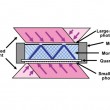Home > Press > Hierarchical Microlattice Structure Increase Specific Strength
 |
| Photo by Dan Little © HRL Laboratories, LLC |
Abstract:
HRL Laboratories in Malibu, California/ USA is a corporate research-and-development laboratory owned by The Boeing Company and General Motors specializing in research into sensors and materials, information and systems sciences, applied electromagnetics, and microelectronics. In November 2011 HLR attracted worldwide attention by announcing that they had developed the world's lightest material with a density of 0.9 mg/cc. Using an innovative fabrication process, researchers created a microlattice structure of interconnected hollow tubes with a wall thickness of 100 nanometers.
Hierarchical Microlattice Structure Increase Specific Strength
Germany | Posted on August 2nd, 2012Recently, Robert E. Doty, Joanna A. Kolodziejska and Alan J. Jacobsen from HLR adapted and extended the process of rapid formation of a polymer microlattice to the fabrication of a hierarchical polymer microlattice structure. The hierarchical microlattice is the result of superposition of two constituent microlattice structures. The constituent microlattice structures are made of the same photopolymer material, and represent two similar, but not identical, architectures.
Compression experiments suggest that the introduction of hierarchy increase the specific plateau stress. The specific peak strength of the unconstrained hierarchical microlattice is roughly equal to that of the large-scale constituent lattice with a fixed node constraint and is approximately 50% higher than the constrained small-scale microlattice. The energy absorbed during compression of the hierarchical structures was equal to or greater than the sum of the energy absorbed by the small and large-scale lattice structures with the same constraint. The researchers conclude this is a result of the additional constraint between the small and large unit cell lattice structures that comprise the hierarchical structure.
In addition to the hierarchical microlattice or the microlattice structure of interconnected hollow tubes, many other lattice-like topologies are possible. Possible variations in cellular architecture, including the relative size scales of the constituent lattices, relative densities, strut angles, and lattice symmetry, offer the opportunity to enlarge the design space for tailored lattice-structured materials.
####
For more information, please click here
Copyright © Wiley-VCH Materials Science Journals
If you have a comment, please Contact us.Issuers of news releases, not 7th Wave, Inc. or Nanotechnology Now, are solely responsible for the accuracy of the content.
| Related News Press |
News and information
![]() Simulating magnetization in a Heisenberg quantum spin chain April 5th, 2024
Simulating magnetization in a Heisenberg quantum spin chain April 5th, 2024
![]() NRL charters Navy’s quantum inertial navigation path to reduce drift April 5th, 2024
NRL charters Navy’s quantum inertial navigation path to reduce drift April 5th, 2024
![]() Discovery points path to flash-like memory for storing qubits: Rice find could hasten development of nonvolatile quantum memory April 5th, 2024
Discovery points path to flash-like memory for storing qubits: Rice find could hasten development of nonvolatile quantum memory April 5th, 2024
Discoveries
![]() Chemical reactions can scramble quantum information as well as black holes April 5th, 2024
Chemical reactions can scramble quantum information as well as black holes April 5th, 2024
![]() New micromaterial releases nanoparticles that selectively destroy cancer cells April 5th, 2024
New micromaterial releases nanoparticles that selectively destroy cancer cells April 5th, 2024
![]() Utilizing palladium for addressing contact issues of buried oxide thin film transistors April 5th, 2024
Utilizing palladium for addressing contact issues of buried oxide thin film transistors April 5th, 2024
Materials/Metamaterials/Magnetoresistance
![]() Nanoscale CL thermometry with lanthanide-doped heavy-metal oxide in TEM March 8th, 2024
Nanoscale CL thermometry with lanthanide-doped heavy-metal oxide in TEM March 8th, 2024
![]() Focused ion beam technology: A single tool for a wide range of applications January 12th, 2024
Focused ion beam technology: A single tool for a wide range of applications January 12th, 2024
Announcements
![]() NRL charters Navy’s quantum inertial navigation path to reduce drift April 5th, 2024
NRL charters Navy’s quantum inertial navigation path to reduce drift April 5th, 2024
![]() Discovery points path to flash-like memory for storing qubits: Rice find could hasten development of nonvolatile quantum memory April 5th, 2024
Discovery points path to flash-like memory for storing qubits: Rice find could hasten development of nonvolatile quantum memory April 5th, 2024
|
|
||
|
|
||
| The latest news from around the world, FREE | ||
|
|
||
|
|
||
| Premium Products | ||
|
|
||
|
Only the news you want to read!
Learn More |
||
|
|
||
|
Full-service, expert consulting
Learn More |
||
|
|
||








